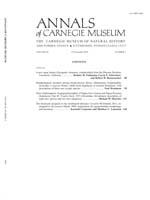Kenneth Carpenter, Matthew C. Lamanna
Annals of Carnegie Museum 83 (2), 149-165, (15 November 2015) https://doi.org/10.2992/007.083.0201
KEYWORDS: Ankylopollexia, Camptosaurus, Cumnoria, Dryosauridae, Dysalotosaurus, Dinosaur National Monument, Morrison Formation, Upper Jurassic
The braincase from the Upper Jurassic (lower Tithonian) Morrison Formation of the Carnegie Quarry at Dinosaur National Monument (Utah), which was assigned to the ankylopollexian iguanodontian ornithopod dinosaur Uteodon aphanoecetes (Carpenter and Wilson, 2008) is actually that of the dryosaurid iguanodontian Dryosaurus cf. D. altus (Marsh, 1878). The purported braincase autapomorphy of U. aphanoecetes, occipital condyle projects farther ventrally than basal tubera, is an artifact of damage to the latter structures in this specimen. The newly identified braincase of Dryosaurus Marsh, 1894, reveals features that are not easily observed in other specimens of this taxon, such as well-developed fossae on the anterior surfaces of the paroccipital processes and a spike-shaped parasphenoid that lacks the dorsal process seen in Dysalotosaurus Virchow, 1919. The distinction of this latter dryosaurid genus from Dryosaurus is here regarded as tentative.
The removal of the braincase in question from the hypodigm of U. aphanoecetes substantially reduces the morphological difference between this taxon and another ankylopollexian species, Camptosaurus dispar (Marsh, 1879). Furthermore, some of the postcranial characters used to support the proposed sister-taxon relationship of U. aphanoecetes and Cumnoria prestwichii (Hulke, 1880) are based on hypothetical reconstructions of selected skeletal elements of the latter, or are more widespread within Ornithopoda. The ilium of Cumnoria prestwichii cannot currently be distinguished from that of Camptosaurus dispar based on known material. Indeed, the only presently recognized autapomorphy of Cumnoria prestwichii is the small size of the opening into the maxillary sinus on the dorsomedial side of the maxilla (i.e., the intramaxillary fossa); in Camptosaurus dispar, by contrast, this opening is large and occupies most of the dorsomedial surface of the bone. This single feature is not considered sufficient to warrant the continued separation of the genera Camptosaurus Marsh, 1885, and Cumnoria Seeley, 1888. Similarly, the anatomical differences between U. aphanoecetes and Camptosaurus dispar are regarded as meriting distinction at the species rather than the genus level. Consequently, the genera Cumnoria Seeley, 1888, and Uteodon McDonald, 2011, are here regarded as junior subjective synonyms of Camptosaurus Marsh, 1885 (Cumnoria as revised synonymy, and Uteodon as new synonymy). The species Cumnoria prestwichii and Uteodon aphanoecetes are returned to the genus Camptosaurus, as Camptosaurus prestwichii, revised combination, and Camptosaurus aphanoecetes, revised combination, respectively.

